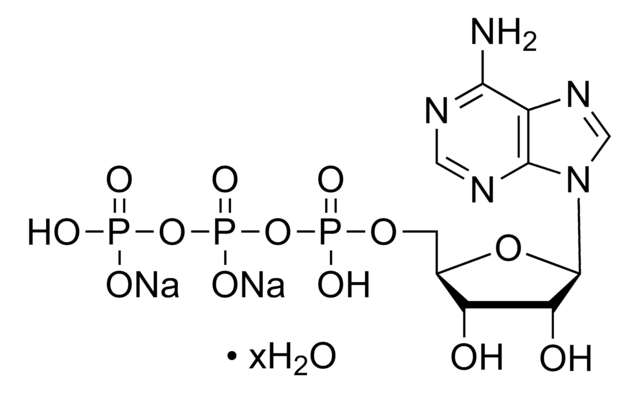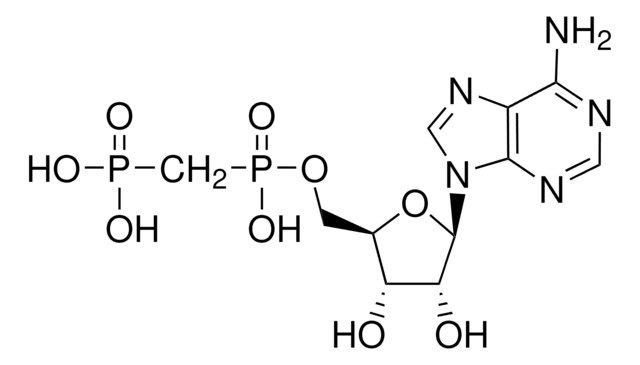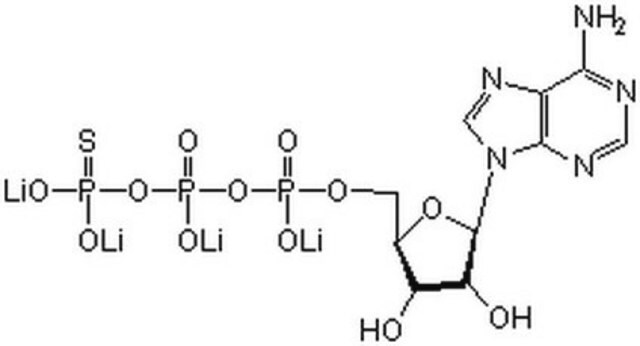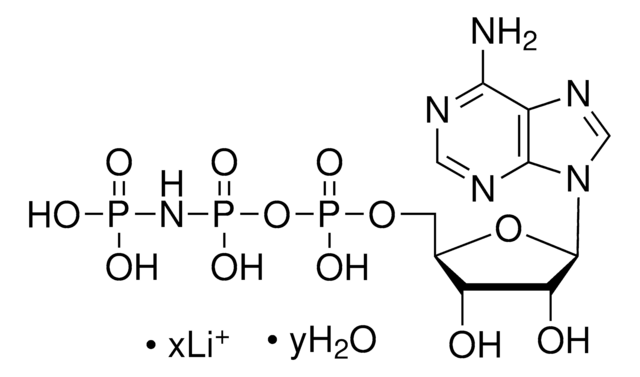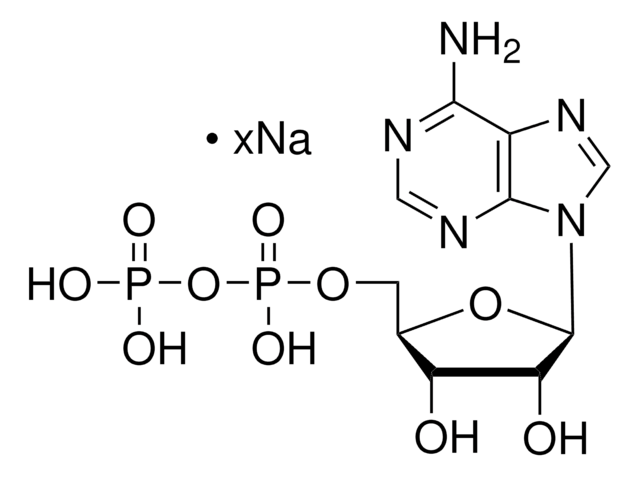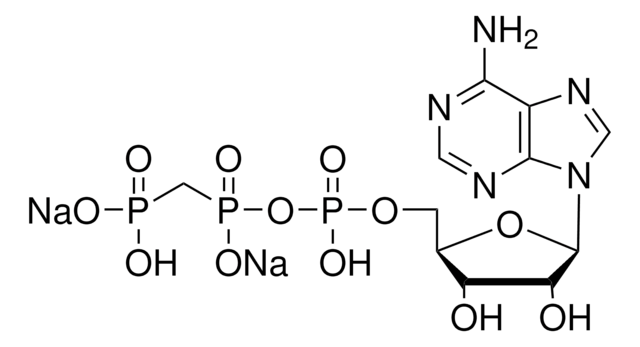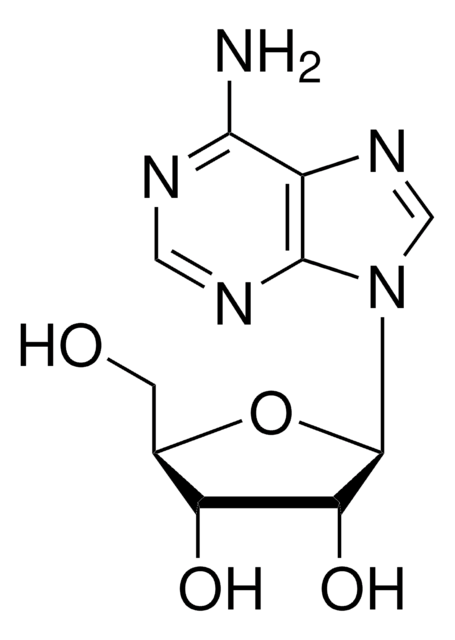A8016
Adenosine 5′-[β-thio]diphosphate trilithium salt
≥80% (HPLC)
동의어(들):
ADP-β-S, Adenosine-5′-0-(2-thiodiphosphate) trilithium salt, Ado-5′-PP[S]
로그인조직 및 계약 가격 보기
모든 사진(1)
About This Item
실험식(Hill 표기법):
C10H12Li3N5O9P2S
CAS Number:
Molecular Weight:
461.07
MDL number:
UNSPSC 코드:
41106305
eCl@ss:
32160414
PubChem Substance ID:
NACRES:
NA.77
추천 제품
분석
≥80% (HPLC)
양식
powder
저장 온도
−20°C
SMILES string
[Li+].[Li+].[Li+].Nc1ncnc2n(cnc12)[C@@H]3O[C@H](COP([O-])(=O)OP([O-])([O-])=S)[C@@H](O)[C@H]3O
InChI
1S/C10H15N5O9P2S.3Li/c11-8-5-9(13-2-12-8)15(3-14-5)10-7(17)6(16)4(23-10)1-22-25(18,19)24-26(20,21)27;;;/h2-4,6-7,10,16-17H,1H2,(H,18,19)(H2,11,12,13)(H2,20,21,27);;;/q;3*+1/p-3/t4-,6-,7-,10-;;;/m1.../s1
InChI key
CPKFUAYUUSSFFZ-MSQVLRTGSA-K
유사한 제품을 찾으십니까? 방문 제품 비교 안내
애플리케이션
Adenosine 5′-[β-thio]diphosphate is a substrate and inhibitor for AMP dependent enzyme systems. Adenosine 5′-[β-thio]diphosphate has been used to explore the myenteric control mechanisms of human esophageal motility and the effect of nitrergic and nonnitrergic neurotransmitters.
Adenosine 5′-[β-thio]diphosphate trilithium salt has been used to induce neuropathic pain in rats to study the effect of dorsal horn cannabinoid CB2 receptor activation on the expression of P2Y12 and P2Y13 (purinoceptors) receptors.
생화학적/생리학적 작용
P2Y receptor agonist.
특징 및 장점
This compound is featured on the P2 Receptors: P2Y G-Protein Family page of the Handbook of Receptor Classification and Signal Transduction. To browse other handbook pages, click here.
기타 정보
Non-hydrolyzable ADP analog
기질
Substrate and inhibitor for AMP dependent enzyme systems.
신호어
Warning
유해 및 위험 성명서
Hazard Classifications
Acute Tox. 4 Oral - STOT SE 2
표적 기관
Eyes,Central nervous system
Storage Class Code
11 - Combustible Solids
WGK
WGK 3
Flash Point (°F)
Not applicable
Flash Point (°C)
Not applicable
개인 보호 장비
dust mask type N95 (US), Eyeshields, Faceshields, Gloves
이미 열람한 고객
Activation of dorsal horn cannabinoid CB2 receptor suppresses the expression of P2Y 12 and P2Y 13 receptors in neuropathic pain rats
Niu J, et al.
Journal of Neuroinflammation, 14(1), 185-185 (2017)
Tibor Kiss
The European journal of neuroscience, 21(8), 2177-2185 (2005-05-05)
Members of the mytilus inhibitory peptide (MIP) family play an important role in the modulation of many physiological processes in molluscs. The signal transduction pathways affected by the MIP effect have not, however, been elucidated. Application of guanosine 5'-[gamma-thio]triphosphate tetralithium
Alexander K Filippov et al.
The Journal of neuroscience : the official journal of the Society for Neuroscience, 26(36), 9340-9348 (2006-09-08)
We have shown previously that stimulation of heterologously expressed P2Y1 nucleotide receptors inhibits M-type K+ currents in sympathetic neurons. We now report that activation of endogenous P2Y1 receptors induces inhibition of the M-current in rat CA1/CA3 hippocampal pyramidal cells in
B Lecea et al.
American journal of physiology. Gastrointestinal and liver physiology, 300(5), G782-G794 (2011-02-19)
The aim of this study was to explore the myenteric mechanisms of control of human esophageal motility and the effect of nitrergic and nonnitrergic neurotransmitters. Human circular esophageal strips were studied in organ baths and with microelectrodes. Responses following electrical
R Rodríguez-Rodríguez et al.
British journal of pharmacology, 158(6), 1609-1620 (2009-10-23)
Extracellular nucleotides play a crucial role in the regulation of vascular tone and blood flow. Stimulation of endothelial cell P2Y1 receptors evokes concentration-dependent full dilatation of resistance arteries. However, this GPCR can desensitize upon prolonged exposure to the agonist. Our
자사의 과학자팀은 생명 과학, 재료 과학, 화학 합성, 크로마토그래피, 분석 및 기타 많은 영역을 포함한 모든 과학 분야에 경험이 있습니다..
고객지원팀으로 연락바랍니다.![Adenosine 5′-[γ-thio]triphosphate tetralithium salt ≥75% (HPLC), powder](/deepweb/assets/sigmaaldrich/product/structures/319/398/e29221c2-3649-455b-bd33-583bb017ec7d/640/e29221c2-3649-455b-bd33-583bb017ec7d.png)
